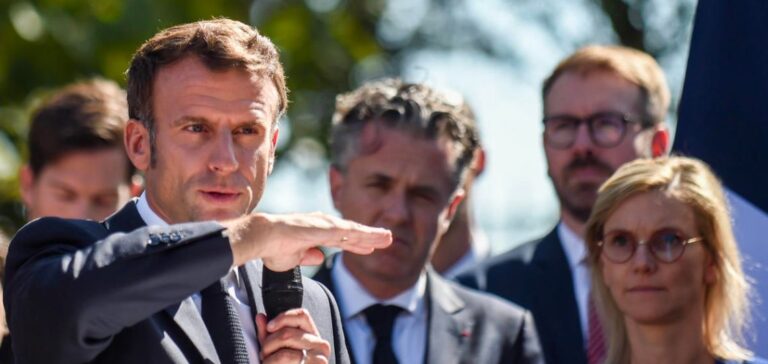Emmanuel Macron announced on Thursday that he wanted to “go twice as fast” in the deployment of renewable energies and accelerate the launch of new nuclear reactors, by inaugurating the first offshore wind farm in France off Saint-Nazaire (Loire-Atlantique).
“Happy days, glorious days!” he said after discovering from a boat the field of 80 wind turbines, deployed from 12 to 20 km from the coast, which will produce electricity for 700,000 people.
“But all this is happening in a complicated time and is still taking too long,” he said, referring to the surge in energy prices with the war in Ukraine that has “turned everything on its head.”
“We will massively increase our electricity needs”, by “40% by 2050″, and France will need to go “twice as fast” on renewable energy projects”, wind and solar in particular, stressed the head of state.
This acceleration must be achieved by simplifying administrative procedures and shortening the time required to examine legal appeals, he said.
Today, it takes an average of ten years for an offshore site to come on stream in France, compared to five years in Germany and six years in the UK. For onshore wind power, it’s seven years, twice as long as in Spain or Germany, and photovoltaics is not much better off.
These measures will be included in the bill on the acceleration of renewable energies, which will be presented Monday in the Council of Ministers, as well as in decrees and government amendments.
Onshore wind power too
On February 10 in Belfort, Emmanuel Macron set the goal of installing about 50 offshore wind farms in France by 2050, with a capacity of 40 gigawatts.
To date, seven wind farms have been awarded to operators, but the implementation of the projects is hampered by numerous appeals, and France is falling behind its neighbors.
After Saint-Nazaire, construction began in Saint-Brieuc, which was the object of friction with the fishermen, Courseulles-sur-Mer and Fécamp. In Oleron, appeals have been filed to push the project further offshore.
“We will have to make wind power on land,” he also pleaded after announcing in Belfort that he wanted to aim for a doubling of its capacity not over 10 but 30 years.
“The onshore wind is concentrated on very few territories,” he lamented, calling for “opening the game” in this area.
Among the tracks of development of the solar, the head of the State evoked “the liberation of the land” to install more panels on the wastelands, by citing the edges of highways and railroads, but also certain agricultural lands with the agrivoltaïsme.
On nuclear power, “the approach is the same”, we must “go much faster” by “simplifying things”, insisted Emmanuel Macron.
“We didn’t invest.”
In Belfort, the Head of State also announced the revival of nuclear power with the construction of six EPR2 reactors by 2035. An audit published in February mentioned the year 2037 for the first commissioning.
As on renewable energies, a text of law is going to allow “to adapt the existing procedures as regards town planning to support the development of the first identified sites” and to launch “as of now the program not to lose time”, he underlined.
“The all ENR does not work, the all nuclear does not work,” justified Emmanuel Macron in the direction of the supporters of both camps.
“And what we are experiencing today with the war (in Ukraine), what some neighbors like the Germans are experiencing even more, is that the key in energy is diversification of the model.”
He also promised a better “sharing of value” for renewable projects with communities and local residents, which will primarily concern offshore wind turbines, often contested.
Jean-Louis Bal, president of the Syndicat des énergies renouvelables (SER), welcomed a “tonic speech”.
For Amandine Lebreton, director of advocacy at the Foundation for Nature and Mankind, on the other hand, “it is not true to say that the delay is due to local or administrative blockages. “We haven’t invested,” she feels.





















